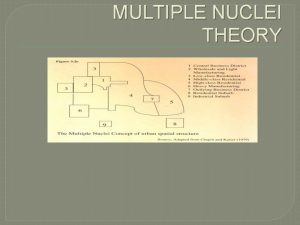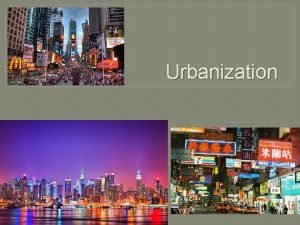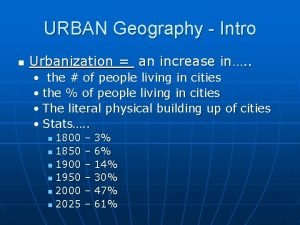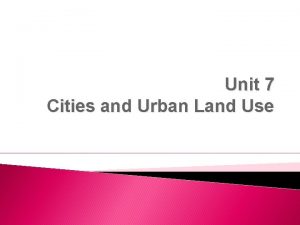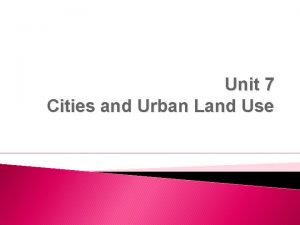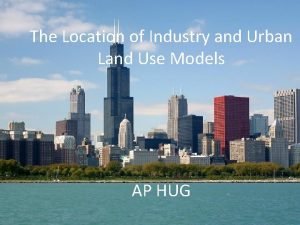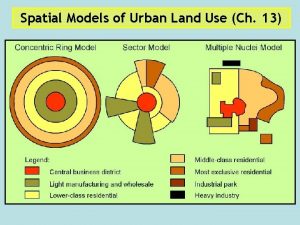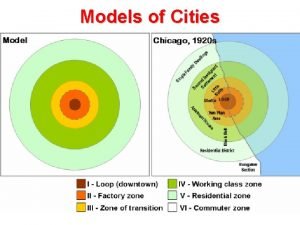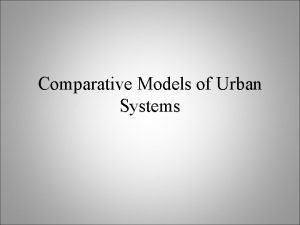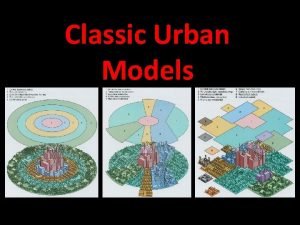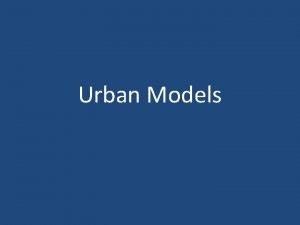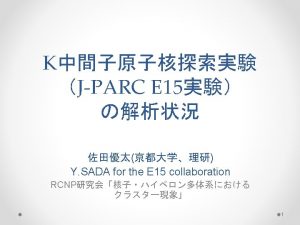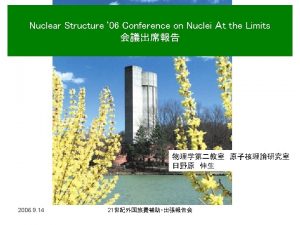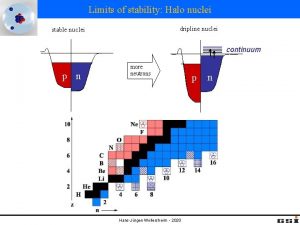MULTIPLE NUCLEI THEORY INTRODUCTION INTRODUCTION This Multiple Nuclei
















- Slides: 16

MULTIPLE NUCLEI THEORY

INTRODUCTION

INTRODUCTION �This Multiple Nuclei model was given by C D Harris and Edward L. Ullman in the year 1945. �It is an economic model and written in the article named “ The Nature of Cities “. �This model is based on the structure and the layout of Chicago. �This model wanted to better describe the economic functions and subsequent land use.

BASIC CONCEPT �Harris and Ullman argued that a city might start with a single central business district (CBD) but over the time the activities scatter and gets modified. �This is because if the main city becomes too large and congested some functions may disperse to form new nuclei. �These scattered activities attract people from the surrounding areas and acts as smaller nuclei in itself.

BASIC CONCEPT �Each nuclei acts as a growth center from a particular kind of land use, such as industry, retail, finance, wholesaling, education or high quality housing. � These small nuclei gain importance and grow in size and starts influencing the growth of activities around them. �Thus, forming multiple nuclei within the city.

LAYOUT

FEATURES �Central Business District (CBD) – It is the economic centre of the urban place. �Wholesale and light manufacturing – This is the place for wholesale business and light metal manufactures. � Low class residential area – It is located closely to the manufacturing unit. Daily wage labourers working in the Light metal manufactures occupy this place because it is close to their working place.

FEATURES � Medium class residential area – It is located close to the CBD and outlying business district. People who go to CBD and outlying business district for their work occupies this area as it is close to their work place. � High Class residential area – It is located on the peripheral of the city and close to outlying business district. It is occupied by people who does not want any disturbance like Industrial noises, pollution etc near their place. This place is deserted in the morning and occupied only in the evening, as people leave for work in the morning and return only in the evening.

FEATURES �Heavy manufacturing – This is located outside the residential areas because it requires regular transportation. It would be difficult for transportation if it was located near the residential areas. �Outlying Business District – This is the portion of an urban area that is normally separated from CBD and fringe area but that supports considerable business activity.

FEATURES �Residential Suburb – Residential areas located outside the urban place and close to the residential areas of urban centre. �Industrial Suburb – Industrial areas located outside the urban place and close to the industrial areas of urban centre.

FACTORS RESPONSIBLE �Certain activities require specialized facilities and concentrate where these facilities are available. For eg: A manufacturing district would not operate well if access to it required large trucks to travel through residential areas. �Certain activities group together because they profit from cohesion. For eg: In retail districts, shoppers can combine several shopping trips into one.

FACTORS RESPONSIBLE � Certain activities are detrimental to each other. For eg: Rail facilities, by interfering with automobile traffic flow, would make movement by automobiles through an industrial area difficult. � Certain activities are unable to afford high rents of the most desirable areas. For eg: Bulk wholesaling and storage require a great deal of room, and could not be located in exclusive retailing areas.

ASSUMPTIONS � It is difficult to find a flat land for big cities and the terrain features affect the activities, development and direction of growth of urban area. � Resources are evenly distributed within the city. � People are homogeneously and evenly distributed in a particular area. � Transportation cost is even in the city and not affected by the location. � A particular activity will locate itself where maximum profit can be earned.

Austin – An Example

CRITICISMS � The height of the buildings are not mentioned. � There is no proper divisions between zones. � Each zone displays a significant degree of internal heterogeneity and not homogeneity. � Unawareness of the opposing forces. � This theory may not be totally applicable to oriental cities with different cultural, economic and political backgrounds. � There is no consideration of influence of physical relief and government policy.

THANK YOU
 Multiple nuclei model.
Multiple nuclei model. Galactic city model
Galactic city model Squatter settlements ap human geography
Squatter settlements ap human geography Bid rent theory example
Bid rent theory example Sprawl aphg
Sprawl aphg Multiple nuclei model definition
Multiple nuclei model definition Harris ullman multiple nuclei model
Harris ullman multiple nuclei model Pros and cons of multiple nuclei model
Pros and cons of multiple nuclei model Commuter zone burgess model
Commuter zone burgess model Similarities between concentric and sector model
Similarities between concentric and sector model Hoyt sector
Hoyt sector Ap human geography models
Ap human geography models Ap human geography sector model
Ap human geography sector model Chauncy
Chauncy Strengths of the multiple nuclei model
Strengths of the multiple nuclei model All three models of urban structure
All three models of urban structure Multiple nuclei model
Multiple nuclei model
